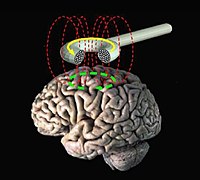
Photo from wikipedia
BACKGROUND Evidence suggests that repetitive transcranial magnetic stimulation (rTMS), a non-invasive neuromodulation technique, alters resting brain activity. Despite anecdotal evidence that rTMS effects wear off, there are no reports of… Click to show full abstract
BACKGROUND Evidence suggests that repetitive transcranial magnetic stimulation (rTMS), a non-invasive neuromodulation technique, alters resting brain activity. Despite anecdotal evidence that rTMS effects wear off, there are no reports of longitudinal studies, even in humans, mapping the therapeutic duration of rTMS effects. OBJECTIVE Here, we investigated the longitudinal effects of repeated low-intensity rTMS (LI-rTMS) on healthy rodent resting-state networks (RSNs) using resting-state functional MRI (rs-fMRI) and on sensorimotor cortical neurometabolite levels using proton magnetic resonance spectroscopy (MRS). METHODS Sprague-Dawley rats received 10 min LI-rTMS daily for 15 days (10 Hz or 1 Hz stimulation, n = 9 per group). MRI data were acquired at baseline, after seven days and after 14 days of daily stimulation and at two more timepoints up to three weeks post-cessation of daily stimulation. RESULTS 10 Hz stimulation increased RSN connectivity and GABA, glutamine, and glutamate levels. 1 Hz stimulation had opposite but subtler effects, resulting in decreased RSN connectivity and glutamine levels. The induced changes decreased to baseline levels within seven days following stimulation cessation in the 10 Hz group but were sustained for at least 14 days in the 1 Hz group. CONCLUSION Overall, our study provides evidence of long-term frequency-specific effects of LI-rTMS. Additionally, the transient connectivity changes following 10 Hz stimulation suggest that current treatment protocols involving this frequency may require ongoing "top-up" stimulation sessions to maintain therapeutic effects.
Journal Title: Brain Stimulation
Year Published: 2019
Link to full text (if available)
Share on Social Media: Sign Up to like & get
recommendations!